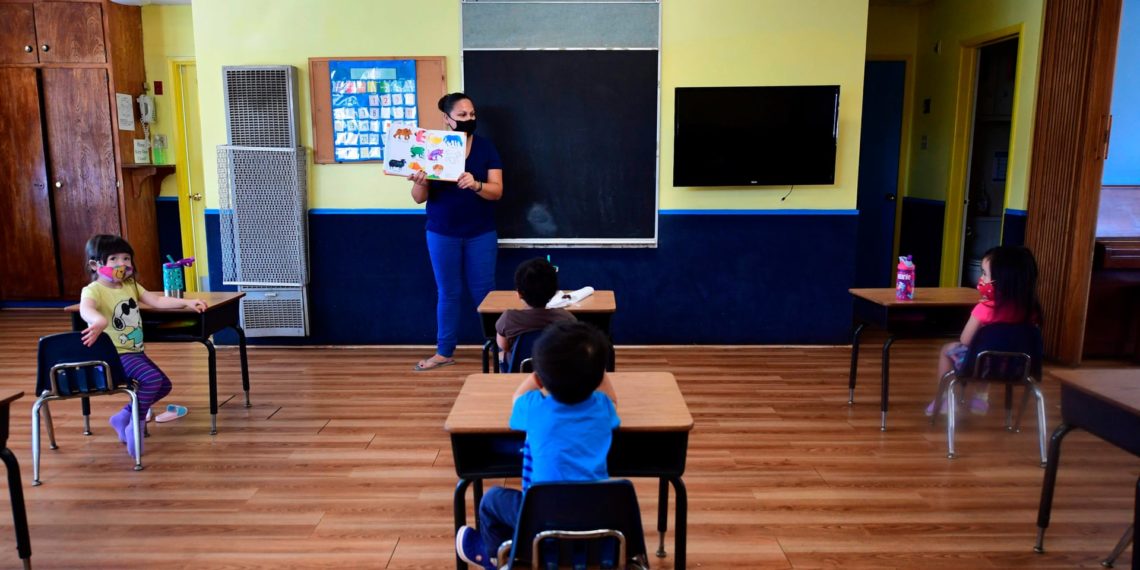For many parents of school-age children, COVID-19 has made the last months dizzying. Those of us who had no intention of being teachers have had to become them on the fly.
But what is the point of going to school really?
I know my children missed out on social skill-building and topical learning for three months this spring, and this may well continue into the fall. But as a scholar of education politics and indigenous rights, I know that my children are also taking a break from being indoctrinated into racist and discriminatory tropes widely embedded in American curricula.
Schools as Sites to Reinforce Dominant Stereotypes
Did your child bring home a pilgrim coloring sheet from school last November? Mine did, from public school in Massachusetts, a state that still features a submissive Native American on the state flag, which activists are petitioning to change.
While many schools and school systems feature “woke” administrators and teachers who teach human rights-based curricula with serious attention to diversity and inclusion issues, many more do not.
The city council in Cambridge wants to remove the Massachusetts state flag from council chambers. https://t.co/UoeUFh6Hy4
The council says it's offensive and not inclusive enough.
Here's what it looks like: pic.twitter.com/JR7LeK4yTP
— Washington Examiner (@dcexaminer) May 15, 2019
Schools remain sites to reinforce dominant stereotypes and the victor’s version of history. In the United States, this version frequently features divinely guided white people subjugating everyone else in the noble pursuit of civilized “free-market” democracy.
More texts have become available to lay out the real history of race relations for a whole range of audiences, including excellent K-12 curricula such as the 1619 Project. Yet these alternative narratives have been slammed by political leaders in ways that showcase the firmly entrenched roots of white supremacy at the highest elected office in the United States.
Education Policies and Assimilation
My current research is on the politics of education for high school-aged students in northern California and southern Mexico. I document how education policies have forced minority students to assimilate into the norms of dominant majorities, and how students are resisting the process of “culturecide,” or cultural genocide, meaning the intentional destruction of a particular group’s culture.
Curricular offerings, educational media content, and teacher ability to be culturally relevant all influence youth identity and participation. So do a host of other variables like family, school and community environment, socio-economic status, trauma levels, mental health, and migration histories.
My research shows that culturally relevant curricula, including mother tongue or heritage tongue classes, increase the well-being of minority students while also increasing intercultural competency for everyone else.
Being exposed to a diverse range of perspectives and material allows students from dominant ethnic backgrounds (in the United States, white people) to be more empathic and be better allies to minority students. The implications of this finding for peaceful coexistence are huge.
Dangerous Single Story
Students often ask in my college classes why they didn’t learn the real stories of Native American genocide earlier in their schooling.
Schools, and society at large, continue to churn out a dangerous single story. Teaching a single story of white supremacy keeps “traditional” values — those from the last few hundred years — firmly ensconced in citizen formation.
Many states rely on the assimilationist practices of schools to form future citizens. Classrooms and educational material such as textbooks are sites where myths of nation-building are passed on from one generation to the next. Schools reinforce dominant ideas about in- and out-groups and shape the norms and expectations for what it means to belong in society.
Un-Schooling White Supremacy
K-12 education systems play a huge role as a safety net for millions of families in the absence of a functional social welfare policy. These systems meet a whole range of needs, from childcare to meals to disability assessment and intervention.
As a college professor and mother of a five and eight-year-old, I am acutely aware of the liberatory role that K-12 school signifies for my own work time. My kids go to school, and I get to teach my classes and write articles like this one.
Yet many curricula across the United States continue to perpetuate culturecide through enforced assimilation — think back to California’s English-only K-12 policies or Arizona’s erasure of ethnic studies programs.
In this new COVID reality, as parents juggle day jobs as well as being their children’s schoolteachers (something which many are eminently unqualified for, myself included), let’s think about how we can un-school our children in the most harmful of myths: that of white supremacy.
And as we revert back to “normal,” whatever and whenever that will be, consider checking in with how cultural representation is happening in the classroom, school, district, and community.
Disclaimer: The views and opinions expressed here are those of the author and do not necessarily reflect the editorial position of The Globe Post.





















